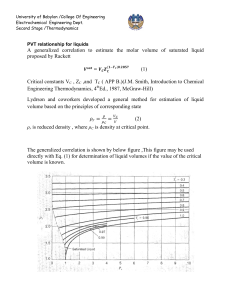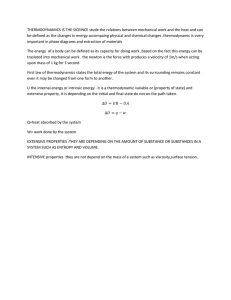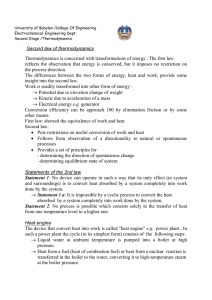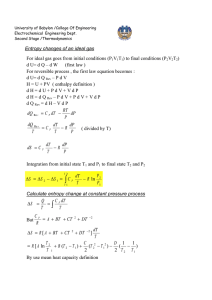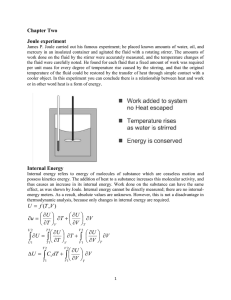University of Babylon /College Of Engineering Electrochemical Engineering Dept. Second Stage /Thermodynamics
advertisement
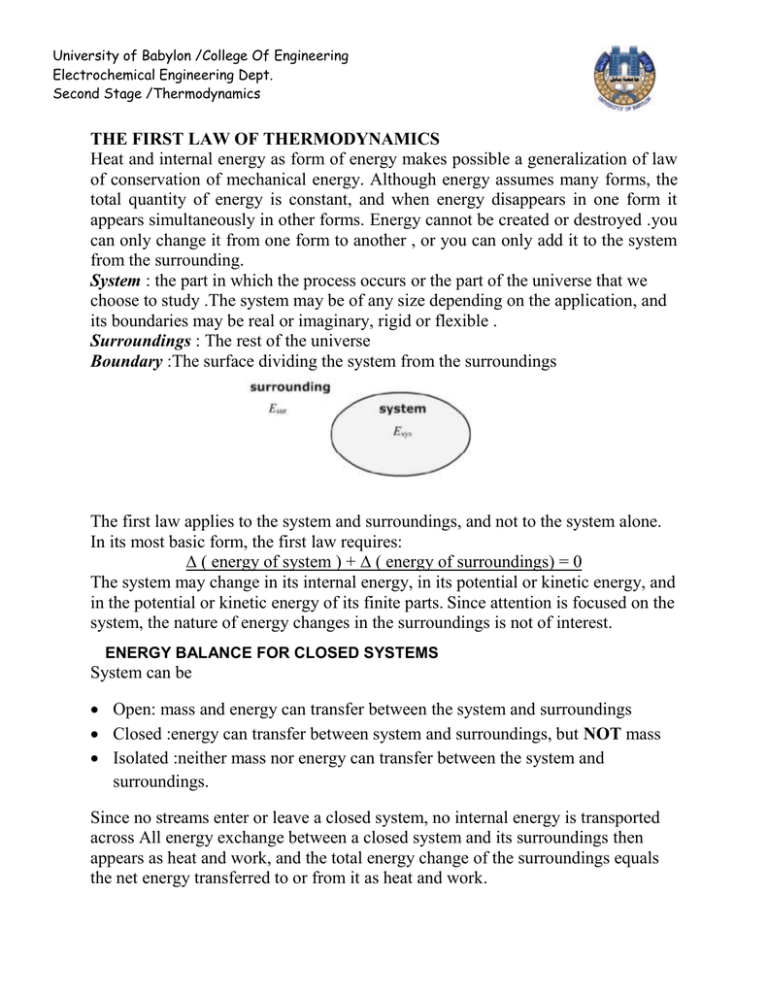
University of Babylon /College Of Engineering Electrochemical Engineering Dept. Second Stage /Thermodynamics THE FIRST LAW OF THERMODYNAMICS Heat and internal energy as form of energy makes possible a generalization of law of conservation of mechanical energy. Although energy assumes many forms, the total quantity of energy is constant, and when energy disappears in one form it appears simultaneously in other forms. Energy cannot be created or destroyed .you can only change it from one form to another , or you can only add it to the system from the surrounding. System : the part in which the process occurs or the part of the universe that we choose to study .The system may be of any size depending on the application, and its boundaries may be real or imaginary, rigid or flexible . Surroundings : The rest of the universe Boundary :The surface dividing the system from the surroundings The first law applies to the system and surroundings, and not to the system alone. In its most basic form, the first law requires: ∆ ( energy of system ) + ∆ ( energy of surroundings) = 0 The system may change in its internal energy, in its potential or kinetic energy, and in the potential or kinetic energy of its finite parts. Since attention is focused on the system, the nature of energy changes in the surroundings is not of interest. ENERGY BALANCE FOR CLOSED SYSTEMS System can be Open: mass and energy can transfer between the system and surroundings Closed :energy can transfer between system and surroundings, but NOT mass Isolated :neither mass nor energy can transfer between the system and surroundings. Since no streams enter or leave a closed system, no internal energy is transported across All energy exchange between a closed system and its surroundings then appears as heat and work, and the total energy change of the surroundings equals the net energy transferred to or from it as heat and work. University of Babylon /College Of Engineering Electrochemical Engineering Dept. Second Stage /Thermodynamics ∆ (Energy of the surroundings ) = ± Q ± W Sign of Q and W depends on which direction of transfer ( 2-1) The energy of system :∆(energy of the system ) = ∆U+ ∆Ek +∆Ep (2-2) By equating equations (2-1) and (2-2) : ∆U+ ∆Ek +∆Ep = ± Q ± W (2-3) Closed systems often undergo processes that cause no change in the system other than in its internal energy. For such processes : U t Q W t Or dU dQ dW (2-4) Hint Properties, such as volume Vt and internal energy Ut depend on the quantity of material in a system; such properties are said to be extensive. In contrast, temperature and pressure, the principal thermodynamic coordinates for homogeneous fluids, are independent of the quantity of material, and are known as intensive properties. An alternative means of expression for the extensive properties of a homogeneous system, such as Vt and Ut, is: Vt = m V or Vt = nV , and Ut = m U or Ut = nU Although Vt and Ut for a homogeneous system of arbitrary size are extensive properties, specific and molar volume V (or density) and specific and molar internal energy U are intensive. Foe closed system of n moles ∆ (n U) = n ∆ U = Q - W or d ( n U ) = n d U = dQ - dW In this form , these equations show explicitly the amount of substance comprising the system Ex: Water flows over waterfall 100 m in height , take 1 kg of water as the system and assume that it does not exchange energy with its surroundings. University of Babylon /College Of Engineering Electrochemical Engineering Dept. Second Stage /Thermodynamics a) What is the potential energy of water at the top of falls with respect to the base of the falls? b) What is the kinetics energy of water just before it strikes bottom ? c) After 1 Kg of water enters the river below the falls , what change has occurred in its state? THERMODYNAMIC STATE AND STATE FUNCTIONS In thermodynamics , there are two types of quantities ; those which depend on path and those are not. there are many examples of quantities which do not depend on path , e.g. temperature , pressure , specific volume. They depend only on present conditions, however reached. Such quantities are known as state functions. We know from experience that for a homogeneous pure substance fixing two of these properties automatically fixes all the others, and thus determines its thermodynamic state. When two of them are held at fixed values for a homogeneous pure substance, the thermodynamic state of the substance is fully determined. This means that a state function, such as specific internal energy, is a property that always has a value; it may therefore be expressed mathematically as a function of other thermodynamic properties, such as temperature and pressure, or temperature and density, and its values may be identified with points on a graph. The differential of a state function represents an infinitesimal change in its value. Integration of such a differential results in a finite difference between two of its values, e.g.: p2 dP P P P 2 1 p1 Work and heat ,on the other hand are not state function ,since they depend on path they cannot identify with points on a graph but they represented by areas, The differentials of heat and work are not changes, but are infinitesimal amounts. When integrated, these differentials give not finite changes, but finite amounts. Thus, dQ Q State function represents a property of a system and always has value , while work and heat appear only when changes are caused in system by process , which required time. There are two classes of properties University of Babylon /College Of Engineering Electrochemical Engineering Dept. Second Stage /Thermodynamics a) Extensive ; depend on quantity of material involved (U ,H , ..) b) Intensive ; independent of quantity of material ( T , p ,..)
